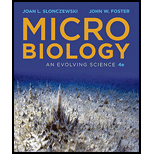
Concept explainers
To review:
The important considerations while designing a strategy to select mutants.
Introduction:
The technique used for identification and selection of individuals having a specific mutantÂ
Explanation of Solution
The important points to remember for designing a mutant selection strategy are as follows:
1. The strategy used should select for mutant bacterial cells by culturing them in a specific condition. In case of loss of function mutation, a master plate of mutagenized cells should be prepared. The cell from this master plate should be replica plated onto a culture plate requiring the wildtype gene function.
2. The selection strategy should test for the presence or absence of the wildtype gene function in the population of mutants. It should be clear from the beginning of the experiment about the functional consequences of the specific mutation in a cell. The study of Escherichia coli O157:H7 genes required for the growth and survival at pH (potential of hydrogen) 2.0 is done through the screening of mutant bacterial cells that are unable to grow at pH 2.
3. The mutant cells should possess a selectable marker like antibiotic resistance gene. This eases the differentiation between wildtype and mutant cells.
4. The identified mutant cells should be further selected using specific DNA (deoxyribonucleic acid) probes. In case of transposon mediated insertional mutation of target genes, a pair of primers is used to amplify the junction between the insertionally inactivated gene and transposon. The sequencing of the amplified product using transposon specific primer determines the insertion site and the gene into which the insertion has taken place.
Want to see more full solutions like this?
Chapter 12 Solutions
Microbiology: An Evolving Science (Fourth Edition)
- please fill in the empty sports, thank you!arrow_forwardIn one paragraph show how atoms and they're structure are related to the structure of dna and proteins. Talk about what atoms are. what they're made of, why chemical bonding is important to DNA?arrow_forwardWhat are the structure and properties of atoms and chemical bonds (especially how they relate to DNA and proteins).arrow_forward
- The Sentinel Cell: Nature’s Answer to Cancer?arrow_forwardMolecular Biology Question You are working to characterize a novel protein in mice. Analysis shows that high levels of the primary transcript that codes for this protein are found in tissue from the brain, muscle, liver, and pancreas. However, an antibody that recognizes the C-terminal portion of the protein indicates that the protein is present in brain, muscle, and liver, but not in the pancreas. What is the most likely explanation for this result?arrow_forwardMolecular Biology Explain/discuss how “slow stop” and “quick/fast stop” mutants wereused to identify different protein involved in DNA replication in E. coli.arrow_forward
- Molecular Biology Question A gene that codes for a protein was removed from a eukaryotic cell and inserted into a prokaryotic cell. Although the gene was successfully transcribed and translated, it produced a different protein than it produced in the eukaryotic cell. What is the most likely explanation?arrow_forwardMolecular Biology LIST three characteristics of origins of replicationarrow_forwardMolecular Biology Question Please help. Thank you For E coli DNA polymerase III, give the structure and function of the b-clamp sub-complex. Describe how the structure of this sub-complex is important for it’s function.arrow_forward
 Human Heredity: Principles and Issues (MindTap Co...BiologyISBN:9781305251052Author:Michael CummingsPublisher:Cengage Learning
Human Heredity: Principles and Issues (MindTap Co...BiologyISBN:9781305251052Author:Michael CummingsPublisher:Cengage Learning Human Biology (MindTap Course List)BiologyISBN:9781305112100Author:Cecie Starr, Beverly McMillanPublisher:Cengage Learning
Human Biology (MindTap Course List)BiologyISBN:9781305112100Author:Cecie Starr, Beverly McMillanPublisher:Cengage Learning Principles Of Radiographic Imaging: An Art And A ...Health & NutritionISBN:9781337711067Author:Richard R. Carlton, Arlene M. Adler, Vesna BalacPublisher:Cengage LearningCase Studies In Health Information ManagementBiologyISBN:9781337676908Author:SCHNERINGPublisher:Cengage
Principles Of Radiographic Imaging: An Art And A ...Health & NutritionISBN:9781337711067Author:Richard R. Carlton, Arlene M. Adler, Vesna BalacPublisher:Cengage LearningCase Studies In Health Information ManagementBiologyISBN:9781337676908Author:SCHNERINGPublisher:Cengage Concepts of BiologyBiologyISBN:9781938168116Author:Samantha Fowler, Rebecca Roush, James WisePublisher:OpenStax College
Concepts of BiologyBiologyISBN:9781938168116Author:Samantha Fowler, Rebecca Roush, James WisePublisher:OpenStax College





